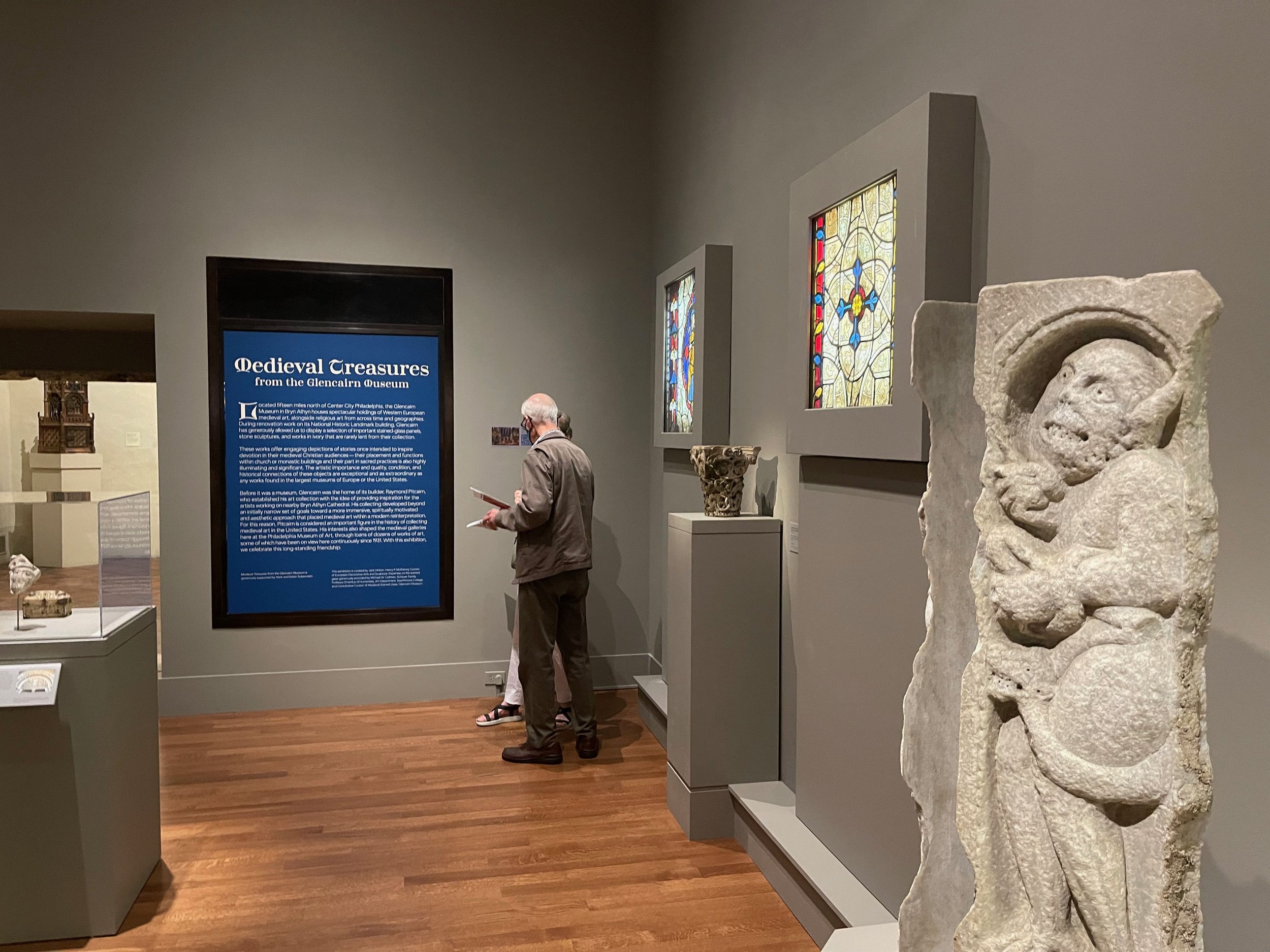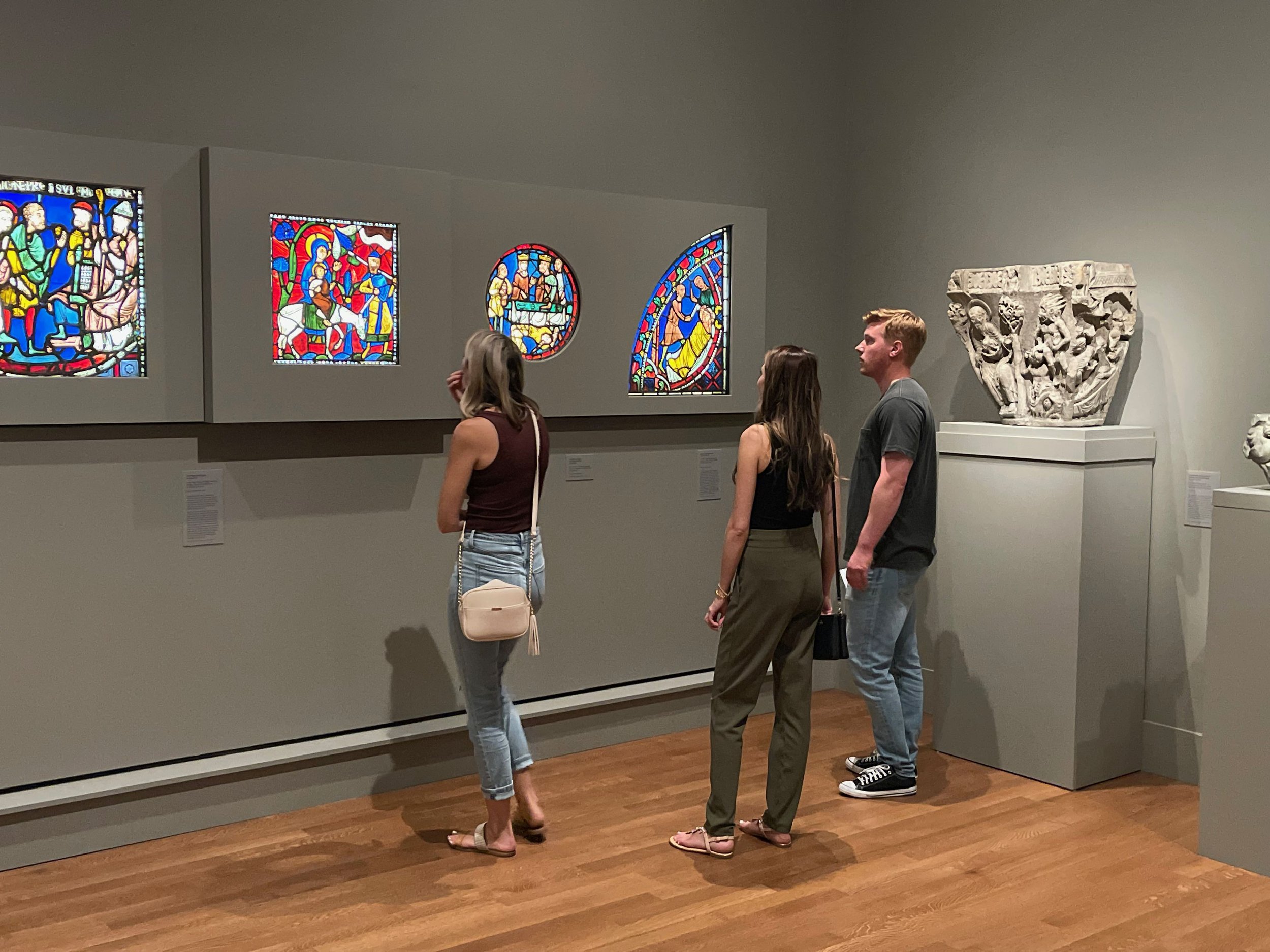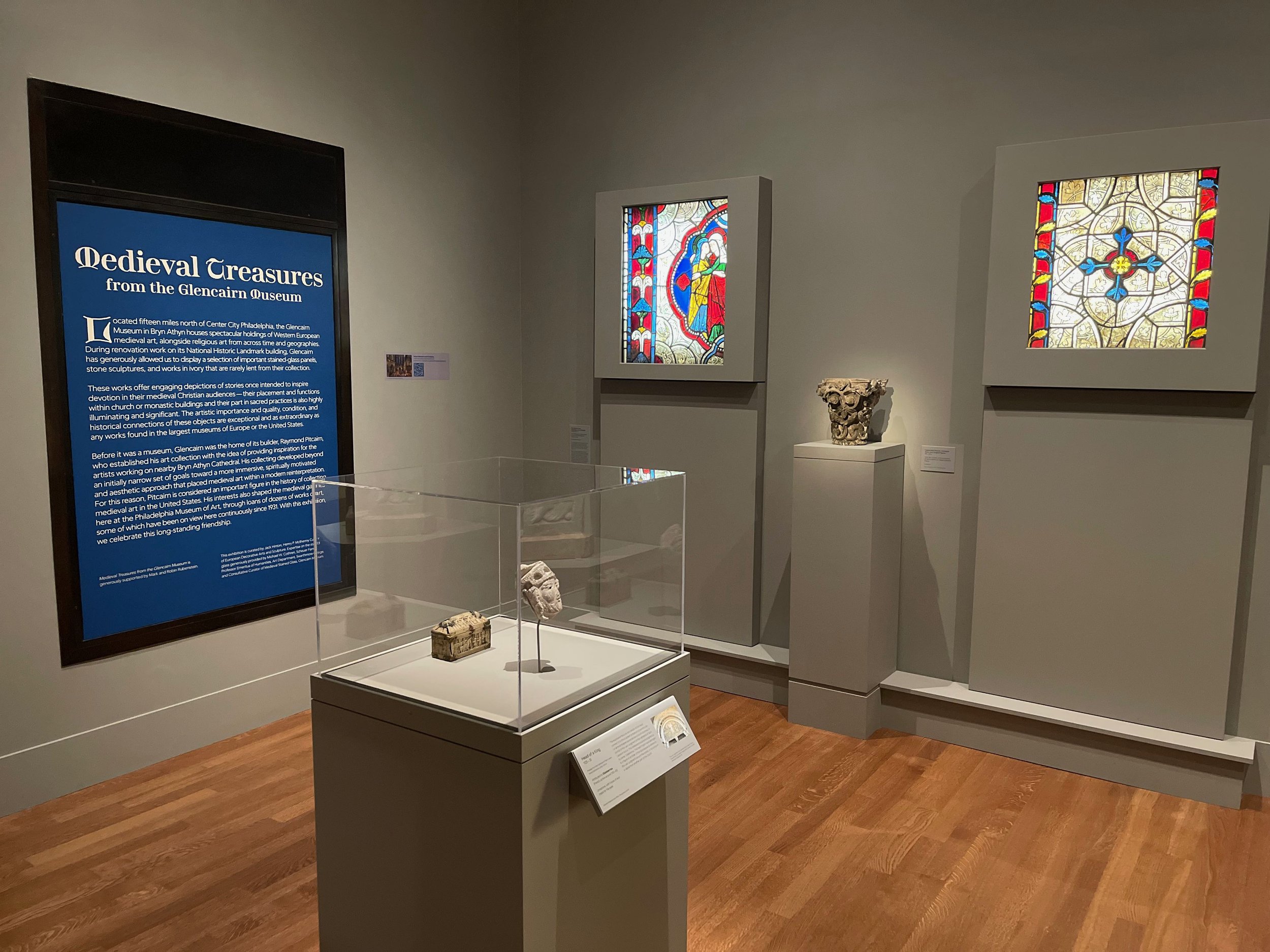Glencairn Museum News | Number 5, 2022
The entrance to Medieval Treasures from the Glencairn Museum, a new exhibition of 17 works of art from the Glencairn Museum collection at the Philadelphia Museum of Art. The exhibition is located in Gallery 307 of the PMA’s medieval wing.
Over the past few decades, Glencairn Museum has loaned works of art to some of the world’s finest museums, including the Metropolitan Museum of Art in New York City, and the Louvre in Paris, France. This tradition of sharing the Glencairn collection with a wider public is in keeping with the example of Raymond Pitcairn himself, who in the 1930s loaned dozens of sculptures, tapestries, and pieces of furniture to the new medieval galleries at the Philadelphia Museum of Art (PMA).
This past spring, Glencairn Museum began a period of closure to the general public for a period of approximately 18 months while we undertake a comprehensive replacement of our National Historic Landmark building’s infrastructure. (More information about this project is here.) While this closure is regrettable, the Museum remains committed to providing access to the collection during this closure through virtual programming, digital resources, and off-site programming. In addition, we have arranged for loan exhibitions at other institutions. The first of these is now on view at the Philadelphia Museum of Art through the fall of 2023: Medieval Treasures from the Glencairn Museum (Figures 1–2).
Figure 1: Medieval Treasures is on exhibition at the Philadelphia Museum of Art through the fall of 2023.
Figure 2: Visitors to Medieval Treasures view examples of 13th-century stained glass from the Glencairn collection.
Medieval Treasures has been curated by Jack Hinton, Henry P. McIlhenny curator of European decorative arts and sculpture at the PMA. Michael W. Cothren, consultative curator of medieval stained glass at Glencairn, has also provided his expertise for the exhibition. In a 2017 essay for Glencairn Museum News, Hinton traced the history of Pitcairn’s loans of medieval objects to the PMA, which “have allowed the visiting public to gain a more complete understanding of the spiritual and devotional purpose surrounding their creation.” (Jack Hinton’s full essay can be read here.)
Figure 3: Gallery 307 of the PMA’s medieval wing in the early stages of preparation for the installation of Medieval Treasures.
Figure 4: A 13th-century stained-glass panel from the Glencairn Museum collection awaits installation in a light box in Gallery 307.
Figure 5: Light boxes being tested with 13th-century stained-glass panels during the installation of the exhibition.
Figure 6: The stained-glass panels were installed in custom frames and backlit with strip lights.
Figure 7: From a Medieval Treasures exhibition label: “The spectacular condition and connection of this panel to a window in the choir of the royal abbey of Saint-Denis, commissioned by the powerful Abbot Suger, make it one of the most important examples of Gothic stained glass in the US.”
Regarding the Medieval Treasures exhibition, Hinton says,
“We are deeply grateful to our friends at Glencairn Museum for these generous loans, which reflect an ongoing collaboration between our institutions dating back to the opening of the PMA’s medieval galleries in 1931. This exciting collaboration further enlivens our medieval spaces with astonishing examples of stained glass and sculpture that bear remarkable narratives intended to teach and inspire the faithful. The juxtaposition of the two collections also sheds light on the broader histories of early medieval and gothic art, as well as the story of how these important gatherings of medieval art came about.”
Figure 8: From a Medieval Treasures exhibition label: “The expressive features and details of this head connect it to the sculpted tympanum (a semicircular or almond-shaped space above a church doorway or portal) of the Last Judgment at the cathedral of Saint Lazare in Autun. This celebrated sculpture [at the cathedral in Autun] is signed by its carver, Gislebertus.”
Figure 9: From a Medieval Treasures exhibition label: “This enigmatic box in luxurious ivory likely held a container of chrism, a holy oil used in Christian baptism or royal coronations.”
The loan of 17 works of art from the Glencairn Museum collection features significant examples of medieval stained glass and architectural sculpture from France, including a colorful panel from the Abbey Church of St. Denis depicting the Flight into Egypt (Figure 7, “one of the most important and best-preserved pieces of early gothic glass in America”) and the head of a king attributed to Gislebertus, the famed sculptor of the 12th-century portal of the Cathedral of Saint Lazare at Autun (Figure 8). The exhibition also includes several remarkable ivories from Spain, such as a box with scenes evoking Palm Sunday on one side, and the Judgment of Solomon on the other (Figure 9). One art historian has called this box “one of the most tantalizing works of art encountered at Glencairn.”
Figure 10: From a Medieval Treasures exhibition label: “This capital (the top section of a column) tells a story from the New Testament of a rich man, Dives, who ignores the suffering of a beggar, Lazarus… Placed on the church exterior, the scene served as an exhortation to viewers to remember their responsibility to care for the less fortunate.”
The introductory panel for Medieval Treasures (Figure 11) explains the historical context of Raymond Pitcairn’s medieval collection and describes the importance of these objects:
“Located fifteen miles north of Center City Philadelphia, the Glencairn Museum in Bryn Athyn houses spectacular holdings of Western European medieval art, alongside religious art from across time and geographies. During renovation work on its National Historic Landmark building, Glencairn has generously allowed us to display a selection of important stained-glass panels, stone sculptures, and works in ivory that are rarely lent from their collection.
Figure 11: An introductory text panel provides the historical context of the Pitcairn medieval collection and describes the artistic importance of these objects.
These works offer engaging depictions of stories once intended to inspire devotion in their medieval Christian audiences—their placement and functions within church or monastic buildings and their part in sacred practices is also highly illuminating and significant. The artistic importance and quality, condition, and historical connections of these objects are exceptional and as extraordinary as any works found in the largest museums of Europe or the United States.
Before it was a museum, Glencairn was the home of its builder, Raymond Pitcairn, who established his art collection with the idea of providing inspiration for the artists working on nearby Bryn Athyn Cathedral. His collecting developed beyond an initially narrow set of goals toward a more immersive, spiritually motivated and aesthetic approach that placed medieval art within a modern reinterpretation. For this reason, Pitcairn is considered an important figure in the history of collecting medieval art in the United States. His interests also shaped the medieval galleries here at the Philadelphia Museum of Art, through loans of dozens of works of art, some of which have been on view here continuously since 1931. With this exhibition, we celebrate this long-standing friendship.”
Glencairn Museum Director Brian Henderson has shared his thoughts on Medieval Treasures in an essay on the PMA’s website: “When the Purpose of Art Is to Transform.” According to Henderson,
“We all seek higher meaning and purpose in our lives. This has always been the case, throughout time and across cultures. We are united in asking enduring questions: Is there a higher power? How am I called to live my life? What will happen to me after death? While these questions and others unify us as humans, there is a rich, beautiful, and enlightening diversity in the ways in which we have answered these questions as individuals, cultures, and faiths. Glencairn Museum seeks to interpret art and artifacts as expressions of faith—as illustrations of religious beliefs and practices around the world and through time.”
Figure 12: Glencairn Museum Director Brian Henderson speaking about Medieval Treasures to a group in the PMA’s medieval wing.
Figure 13: Medieval Treasures is located in Gallery 307 of the PMA’s medieval wing.
Medieval Treasures from the Glencairn Museum will be on view through the fall of 2023 in Gallery 307 of the PMA’s medieval wing.
(CEG)
A complete archive of past issues of Glencairn Museum News is available online here.














